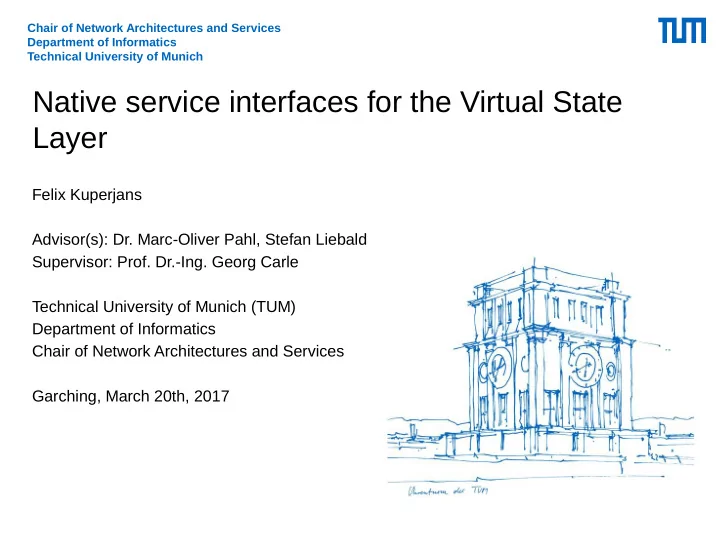

Chair of Network Architectures and Services Department of Informatics Technical University of Munich Native service interfaces for the Virtual State Layer Felix Kuperjans Advisor(s): Dr. Marc-Oliver Pahl, Stefan Liebald Supervisor: Prof. Dr.-Ing. Georg Carle Technical University of Munich (TUM) Department of Informatics Chair of Network Architectures and Services Garching, March 20th, 2017
Overview • Motivation • Requirements and research questions • Usable technologies • Related work • Next steps Felix Kuperjans | Native service interfaces for the Virtual State Layer 2
Motivation • Virtual State Layer connects smart devices ● On many different platforms ● With different kinds of software (“services”) • Services for the Virtual State Layer in many languages • Especially C for embedded devices • Using standardized technologies for: ● Inter-operability ● Better usability for programmers Felix Kuperjans | Native service interfaces for the Virtual State Layer 3
Requirements and research questions Build native interfaces: # Requirement 1 standardized network protocol 2 inter-operability ● Java 3 low overhead of data transfers 4 low latency of a full operation ● C 5 simplicity of the implementation 6 security: encryption, authentication ● Python 7 callback support 8 asynchronous operations ● (FUSE filesystem) 9 stateless/suspendable protocol Felix Kuperjans | Native service interfaces for the Virtual State Layer 4
Usable technologies • Serialization formats: ● XML, JSON, CBOR and protocol buffers • Protocols: ● Will be implemented: HTTP 1.1/2.0, CoAP ● Not suitable: XML-RPC, SOAP, MQTT • Callback techniques: ● Double server, long polling, stateful connections (websockets) and HTTP 2.0 server push • Code generations approaches with IDLs and SWIG Felix Kuperjans | Native service interfaces for the Virtual State Layer 5
Related work • On RESTful design: NEWT (RESTful HPC service) [1] • Comparisions of serialization formats [2][3] • Protocols for IoT systems: ● Multi protocol [4] ● SOAP [5][6] • Protocol comparisons: ● SOAP vs. HTTP with RESTful design [7] ● CoAP vs. HTTP (including library comparison) [8] • Multiple programming languages for cloud services [9] • Using SWIG for C++ library [10] Felix Kuperjans | Native service interfaces for the Virtual State Layer 6
Next steps • Design, implement and evaluate: ● Serialization with XML, JSON, CBOR and protobuf ✓ ● HTTP 1.1 with websockets ( ✓ ) ● HTTP 2.0 with server push ● CoAP with double server approach C and Python connectors ● Evaluation techniques: ● ● Measurement of data size ● Performance measurement ● Qualitative analysis Felix Kuperjans | Native service interfaces for the Virtual State Layer 7
References 1) S. Cholia, D. Skinner, and J. Boverhof, “Newt: A restful service for building high performance computing web applications,” in Gateway Computing Environments Workshop (GCE), 2010. IEEE, 2010, pp. 1–11. 2) Aihkisalo, Tommi and Paaso, Tuomas, “A performance comparison of web service object marshalling and unmarshalling solutions,” in Services (SERVICES), 2011 IEEE World Congress on. IEEE, 2011, pp. 122–129. 3) K. Maeda, “Performance evaluation of object serialization libraries in xml, json and binary formats,” in Digital Information and Communication Technology and it’s Applications (DICTAP), 2012 Second International Conference on. IEEE, 2012, pp. 177–182. 4) P. Desai, A. Sheth, and P. Anantharam, “Semantic gateway as a service architecture for iot interoperability,” in Mobile Services (MS), 2015 IEEE International Conference on. IEEE, 2015, pp. 313–319. 5) N. B. Priyantha, A. Kansal, M. Goraczko, and F. Zhao, “Tiny web services: design and implementation of interoperable and evolvable sensor networks,” in Proceedings of the 6th ACM conference on Embedded network sensor systems. ACM, 2008, pp. 253–266. 6) R. Kyusakov, J. Eliasson, J. Delsing, J. van Deventer, and J. Gustafsson, “Integration of wireless sensor and actuator nodes with it infrastructure using service-oriented architecture,” IEEE Transactions on industrial informatics, vol. 9, no. 1, pp. 43–51, 2013. 7) T. Aihkisalo and T. Paaso, “Latencies of service invocation and processing of the rest and soap web service interfaces,” in Services (SERVICES), 2012 IEEE Eighth World Congress on. IEEE, 2012, pp. 100–107. 8) M. Kovatsch, M. Lanter, and Z. Shelby, “Californium: Scalable cloud services for the internet of things with coap,” in Internet of Things (IOT), 2014 International Conference on the. IEEE, 2014, pp. 1–6. 9) K. Ericson and S. Pallickara, “Adaptive heterogeneous language support within a cloud runtime,” Future Generation Computer Systems, vol. 28, no. 1, pp. 128–135, 2012. 10) N. M. O’Boyle, C. Morley, and G. R. Hutchison, “Pybel: a python wrapper for the openbabel cheminformatics toolkit,” Chemistry Central Journal, vol. 2, no. 1, p. 5, 2008. Felix Kuperjans | Native service interfaces for the Virtual State Layer 8
Questions? Felix Kuperjans | Native service interfaces for the Virtual State Layer 9
Recommend
More recommend